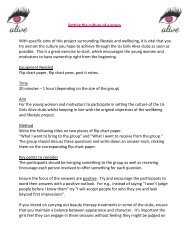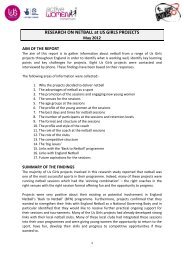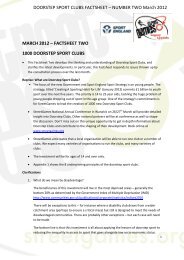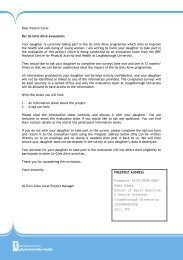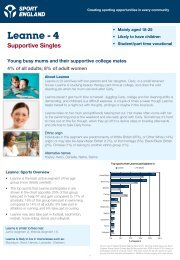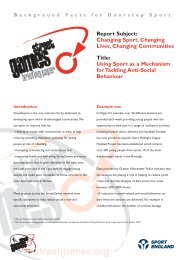factsheet - young women and girls physical activity - Women's Sport ...
factsheet - young women and girls physical activity - Women's Sport ...
factsheet - young women and girls physical activity - Women's Sport ...
Create successful ePaper yourself
Turn your PDF publications into a flip-book with our unique Google optimized e-Paper software.
Notes<br />
1 Data taken from NHS Information Centre Health Survey for Engl<strong>and</strong> (HSE) 2008. Children aged 13-15 were asked questions directly about their<br />
<strong>physical</strong> <strong>activity</strong>, while the parents of children aged 2-12 were asked the questions on the child’s behalf. Existing literature suggests that children are<br />
less likely that adults to accurately report <strong>physical</strong> activities. A total of 7,521 <strong>young</strong> people aged 2-15 were interviewed in 2008. Engl<strong>and</strong> only.<br />
2 Data taken from the DCSF Children <strong>and</strong> Young People’s Participation in Organised <strong>Sport</strong> Omnibus Survey, 2009. ‘Organised <strong>Sport</strong>’ is defined as<br />
‘sport, dance or other <strong>physical</strong> <strong>activity</strong> which is organised <strong>and</strong> led by an instructor like a coach, teacher, sports leader or someone else, including any<br />
training for events or competitions’. ‘Outside the school day’ is defined as ‘either before school starts or after lesson ends including the weekend’. ‘In<br />
<strong>and</strong> out of school’ is defined as ‘both during the school day i.e. during lesson time, including PE lessons, lunchtime, or break times <strong>and</strong> outside the<br />
school day’ as described above. Respondents are asked to recall the previous seven days of <strong>activity</strong> not including the day on which the interview took<br />
place. See table below for bases. Engl<strong>and</strong><br />
All respondents = 11,821<br />
Male Age 5-8 Age 9-12 Age 13-16 Age 17-19<br />
5,878 1,714 1,581 1,544 1,039<br />
Female Age 5-8 Age 9-12 Age 13-16 Age 17-19<br />
5,943 1,438 1,567 1,815 1,123<br />
Those aged 5 to 16 in years R-11 who attended school or college for exactly 5 days in last<br />
week = 6,267<br />
Male Age 5-8 Age 9-12 Age 13-16<br />
3,177 1,222 1,150 805<br />
Female Age 5-8 Age 9-12 Age 13-16<br />
3,090 1,027 1,113 950<br />
3 Data taken from the Department for Education (formerly DCSF) PE <strong>and</strong> <strong>Sport</strong> Survey, 2009/10. All partnership schools in Engl<strong>and</strong> were surveyed with<br />
responses from 21,436 schools (99.8%) <strong>and</strong> 357 FE colleges (99.4%). ‘PE’ is the planned teaching <strong>and</strong> learning programme in curriculum time that<br />
meets the requirements of the national curriculum for <strong>physical</strong> education. ‘High quality’ is defined as ‘producing <strong>young</strong> people with the skills,<br />
underst<strong>and</strong>ing, desire <strong>and</strong> commitment to continue to improve <strong>and</strong> achieve in a range of PE, sport <strong>and</strong> health-enhancing <strong>physical</strong> activities, in line with<br />
their abilities’. ‘School sport’ includes any <strong>activity</strong> that requires <strong>physical</strong> skilfulness <strong>and</strong> is part of the school’s planned formal, semi-formal, supervised or<br />
led provision. School sport typically takes place out of school hours. Engl<strong>and</strong><br />
4 Data taken from the DCMS Taking Part Child Survey 2009/10. Boys, <strong>and</strong> <strong>girls</strong> age 5-15 were asked about their engagement <strong>and</strong> non-engagement in<br />
sport activities during the four weeks prior to interview. To count, the respondent must have participated in the <strong>activity</strong> for at least 30 minutes. Engl<strong>and</strong><br />
5 Data from the Youth <strong>Sport</strong> Trust’s Voice of the Young Survey, 2007. Base = 1,122 <strong>young</strong> people aged from under 11 to 18; 524 boys <strong>and</strong> 598 <strong>girls</strong>.<br />
Great Britain<br />
6 Data taken from Girlguiding UK Girls Shout Out! Survey, 2007. Bases: <strong>girls</strong> aged 10-15 =1,039; <strong>girls</strong> aged 16-25 =581. UK<br />
7 Data taken from Girlguiding UK Girls’ Attitudes Survey, 2010. Around 1,200 <strong>girls</strong> aged 7-21 were asked their attitudes to key social, political <strong>and</strong><br />
economic issues. UK<br />
8 Data taken from the WSFF’s BMRB Omnibus Survey, November 2008. Bases: <strong>girls</strong> aged 10-15 =56; <strong>young</strong> <strong>women</strong> aged 16-20 = 62. Great Britain<br />
Women’s <strong>Sport</strong> <strong>and</strong> Fitness Foundation<br />
3 rd Floor, Victoria House, Bloomsbury Square, London WC1B 4SE Tel: 020 7273 1740 Email: insight@wsff.org.uk www.wsff.org.uk<br />
Women’s <strong>Sport</strong> <strong>and</strong> Fitness Foundation Young <strong>women</strong> <strong>and</strong> <strong>girls</strong>’ <strong>physical</strong> <strong>activity</strong>: December 2010




